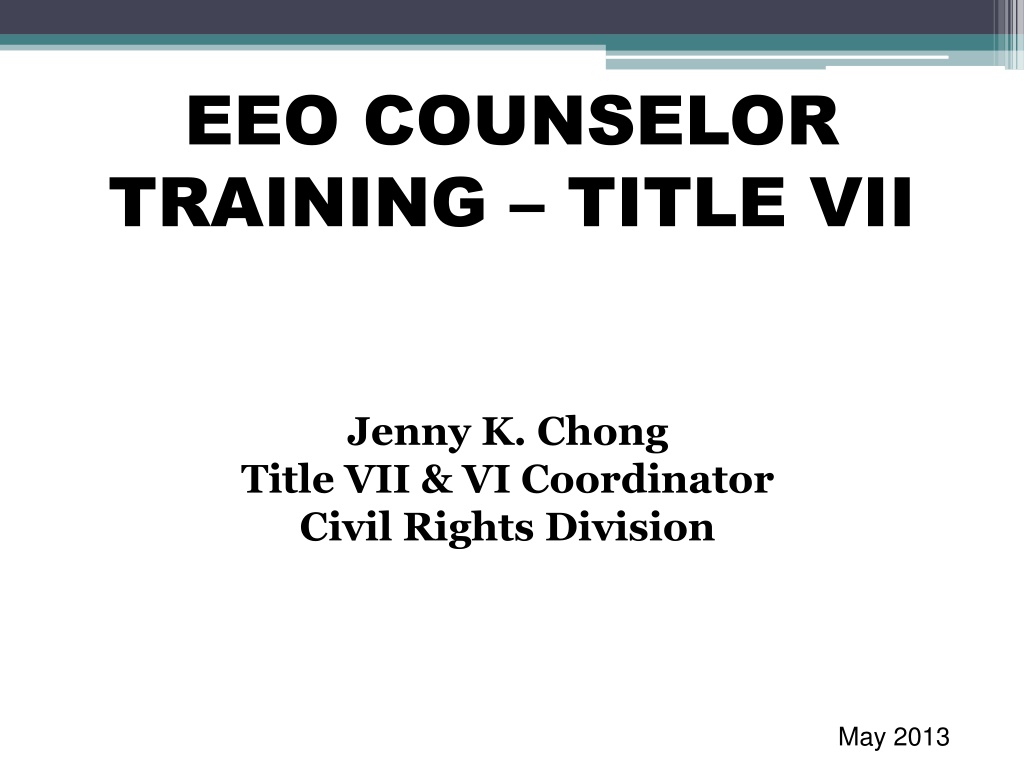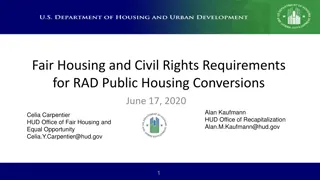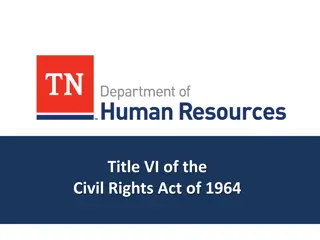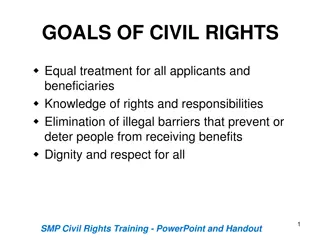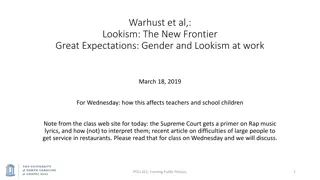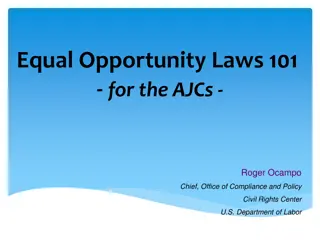Understanding Title VII of the Civil Rights Act
Title VII of the Civil Rights Act of 1964 prohibits employment discrimination based on various factors such as race, color, sex, religion, national origin, age, disability, and genetic information. It covers all phases of employment, including hiring, terms and conditions, benefits, and post-employment actions. The act also forbids retaliation against employees who oppose unlawful practices or participate in investigations related to Title VII. This comprehensive legislation aims to ensure equal opportunities in the workplace and prevent discrimination based on illegal EEO factors.
Download Presentation

Please find below an Image/Link to download the presentation.
The content on the website is provided AS IS for your information and personal use only. It may not be sold, licensed, or shared on other websites without obtaining consent from the author. Download presentation by click this link. If you encounter any issues during the download, it is possible that the publisher has removed the file from their server.
E N D
Presentation Transcript
EEO COUNSELOR TRAINING TITLE VII Jenny K. Chong Title VII & VI Coordinator Civil Rights Division May 2013
CLARIFICATION Title VI (6) External Complaints Contractors, public members, recipients Designees Title VII (7) Internal Complaints Employees EEO Counselors
TITLE VII CIVIL RIGHTS ACT OF 1964 Title VII of the Civil Rights Act of 1964 prohibits employment discrimination based on race, color, sex, religion, national origin, age, disability or genetic information. Title VII of the Civil Rights Act of 1964 forbids an employer from retaliating against an employee because of the employee s opposition to any practice made an unlawful practice by Title VII, or the employee s participation in an investigation, proceeding, or hearing under [Title VII]. 42 U.S.C. 2000e-3(a).
BASIS Race Color Sex Religion National Origin Age Disability Genetic Information Retaliation All phases of employment are covered.
DISCRIMINATION Basing employment decisions on illegal EEO basis instead of on merit, experience, qualifications Applies to all aspects of employment: Hiring Terms and conditions Benefits and privileges Post employment
RACE DISCRIMINATION Difference in treatment based upon race Hair texture Skin color Facial features Victim and person can be the same race or color.
COLOR DISCRIMINATION Difference in treatment based upon color Pigmentation Complexion Skin shade or tone
SEX DISCRIMINATION Glass ceiling issues Pregnancy Job segregation Sexual favoritism Harassment Sexual harassment
RELIGIOUS DISCRIMINATION Religious beliefs Dress codes Religious expression
RELIGIOUS ACCOMMODATION Belief conflicts with work requirements Reasonable accommodations Employee must inform employer of belief/practice in conflict with job duty Undue hardship
NATIONAL ORIGIN DISCRIMINATION Physical, linguistic or cultural characteristics Language and accent Ethnic slurs and epithets
AGE DISCRIMINATION Applies to individuals 40 and over Stereotypes and misconception about abilities Appearance Retirement eligibility Years of experience Dated education or training
DISABILITY DISCRIMINATION Assumptions and generalizations Fear Lack of awareness Resistance to individuals deemed different
DISABILITY Physical or mental impairment that substantially limits a major life activity Record of impairment Regarded as having impairment
GENETIC INFORMATION NONDISCRIMINATION ACT of 2008 The law forbids discrimination on the basis of genetic information when it comes to any aspect of employment, including hiring, firing, pay, job assignments, promotions, layoffs, training, fringe benefits, or any other term or condition of employment. An employer may never use genetic information to make an employment decision because genetic information is not relevant to an individual's current ability to work.
GINA EXCEPTIONS GINA EXCEPTIONS Casual conversation Voluntary basis Wellness programs FMLA leave Commercially and publicly available documents Genetic monitoring programs or DNA testing
RETALIATION All of the laws we enforce make it illegal to fire, demote, harass, or otherwise retaliate against people (applicants or employees) because they filed a charge of discrimination, because they complained to their employer or other covered entity about discrimination on the job, or because they participated in an employment discrimination proceeding (such as an investigation or lawsuit).
RETALIATION Elements of a retaliation claim Protected activity Alleged retaliator knew of the protected activity Adverse action Causal connection between protected activity and adverse action
SEXUAL HARASSMENT Unwelcome conduct based on protected basis Tangible job action Hostile environment
SEXUAL HARASSMENT SEXUAL HARASSMENT Can involve Co-worker Supervisor Supervisor in another area Non-employee (client, contractors, temporary workers, etc.) Victim and harasser can be any gender Harasser does not have to be of opposite sex
TITLE VII TITLE VII WEBSITE INFORMATION WEBSITE INFORMATION
FORMAL COMPLAINTS FILING (INTERNALLY) Individuals can file directly with the: 1. Civil Rights Division OR 2. Grievance process in Human Resources
MEDIATION Encouraged to resolve at lowest level VOLUNTARY All individuals must agree in order to take place
BENEFITS OF MEDIATION Oklahoma Merit Protection Commission s (MPC) Mediation Program (www.mpc.ok.gov) Free Non-bias mediator Anyone can request Venting, personality issues, formal complaints
MEDIATION AGREEMENTS Signed by MPC Director Binding by Merit Rules Grievance can filed if agreement is broken
MEDIATION Investigation will continue if an agreement is not formed during mediation Individual does not lose anything by trying mediation first
FILING WITH CIVIL RIGHTS DIVISION Form available online or by contacting Civil Rights Division Filed no later than 180 calendar days following: Date of the alleged action of discrimination; or Where there has been a continuing course of conduct, the date on which that conduct was discovered
FILING CIVIL RIGHTS TIMEFRAMES Ten (10) business days Acknowledge receipt Sixty (60) days Investigation completed Ninety (90) calendar days Final decision by ODOT Director
FILING WITH HUMAN RESOURCES Individual uses Grievance Form Filed no later than 20 calendar days following: Date of the alleged action of discrimination; or Where there has been a continuing course of conduct, the date on which that conduct was discovered
FILING HUMAN RESOURCES TIMEFRAMES * All discrimination grievances will be forwarded to the Civil Rights Division for investigation. 45 calendar days Resolved 15 days extend resolution for good cause 30 days mutually extend resolution Not to exceed 90 calendar days ODOT Director makes final decision
FORMAL COMPLAINTS FILING (EXTERNALLY) Individual can also file externally with: Oklahoma Merit Protection Commission Attorney General s Office Equal Employment (EEOC) Opportunity Commission Individual can also file in multiple entities (internally & externally)
EEO COUNSELORS ROLES & RESPONSIBILITIES
EEO COUNSELOR Provide information to your division on: Title VII website Complaint form & complaint process Complaint form (let employee fill out the form) Post notice or inform division you are the EEO counselor Be alert on any issues can could be discriminatory
EEO COUNSELOR Be helpful to others in your division Remain confidentiality Do NOT tell supervisor if employee vents to you (let Civil Rights handle proper procedures) Inform Civil Rights Division on formal complaints or potential issues
TITLE VII COORDINATOR CONTACT Jenny Chong Title VII & VI Coordinator Civil Rights Division (w) 405-521-2072 (c) 405-423-4130 jchong@odot.org
